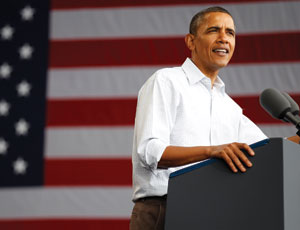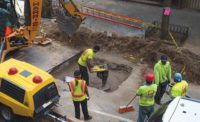President Obama’s Labor Day call for a new transportation infrastructure program could move public-works spending closer to the national political debate’s front burner. So far, Obama and White House officials have offered only an outline that doesn’t specify how much they want to spend or precisely how the program would work.

If the framework were converted to detailed legislative language, it would face a tough path on Capitol Hill this year. For one thing, Obama’s plan quickly drew harsh blasts from congressional Republicans. Moreover, the Hill is on a tight schedule: Only about three weeks remain before lawmakers recess before the Nov. 2 elections. They may return later for a lame-duck session.
In his Sept. 6 speech, Obama sketched out what he termed “a new plan for rebuilding and modernizing America’s roads and rail and runways for the long term.” Construction officials praised the President’s endorsement of the need for federal transportation spending. Brian Deery, senior director of the Associated General Contractors’ highway and transportation division, says, “We’re pleased that the President’s talking about infrastructure, recognizing the need for infrastructure investment, both long term and short term.” But industry observers had at least as many questions as answers about what Obama has in mind.
The American Road & Transportation Builders Association is “cautiously optimistic” about the proposal, says spokesman Jeff Solsby. He adds, “The concern is [that] the devil’s in the details.” So far, details are in short supply.
According to a White House summary, the plan would cover six years and include a new surface-transportation reauthorization. The last authorization expired in September 2009. Since then, highway and transit programs have run under extensions because legislators haven’t agreed on how to finance a long-term bill. The latest stopgap lapses on Dec. 31.
Obama’s plan would be front-loaded with an initial $50 billion, with the aim of creating jobs, according to the White House. But the President did not provide a price tag for his entire proposal.
The plan has some new elements, including an infrastructure bank, which would use federal, state, local and private funds to “focus on investments of national and regional significance.” AGC likes the infrastructure-bank idea, says Deery. However, he adds, “It’s certainly not the answer to the [infrastructure funding] problem. It’s a supplement on top of everything else.”
Furthermore, President Obama calls for folding the fledgling, highly popular federal high-speed-rail effort into the new surface-transportation program, putting it on “equal footing” with highways and other modes of transportation.
In addition, the plan would consolidate more than 100 current federal programs, which, Obama said, “too often duplicate each other.” The proposal also would require states to compete for some funds, as they now do for high-speed-rail grants. Obama wants to spend more transportation funds on safety, sustainability and “livability.”
Jay Hansen, the National Asphalt Pavement Association’s vice president for government affairs, says, “We have now something to rally around and try to push … before the Congress adjourns.” However, he says, “The politics is tough on this, very tough.”
| • Six-year “framework” |
| • $50-billion “up-front investment” |
| • Put high-speed rail on “equal footing” with highways and other modes of transportation |
| • New transportation infrastructure bank |
| • “Robust” spending on aviation, including runways |
| • Consolidate more than 100 current programs |
| • Have states compete for some funds |
| • Boost spending on safety, sustainability and “livability” |
| Hurdles Ahead: |
|---|
| • Little time left in congressional session |
| • Strong Republican opposition |
| • Getting lawmakers to agree on how to finance |
| Source: White House, industry sources, ENR |



Post a comment to this article
Report Abusive Comment